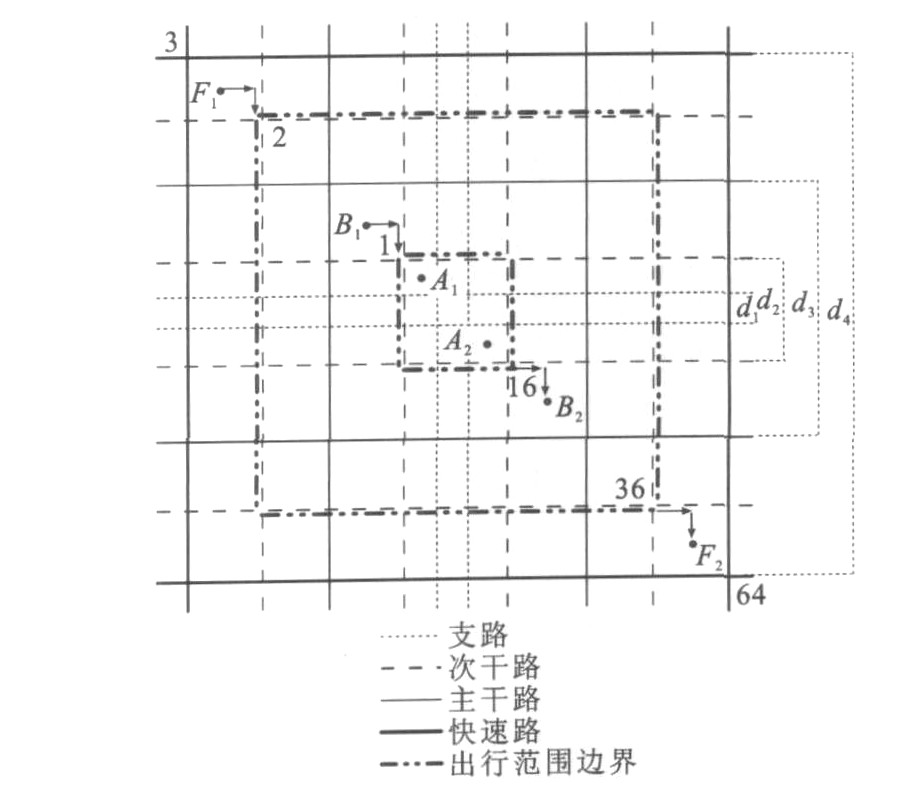-
摘要: 为了合理体现交通事故延误对出行者路径选择的影响, 提出了随机状态下的交通事故时间延误模型。将交通事故的随机性、持续时间和道路通行能力等不确定性因素引入到交通分配模型中, 并对路径选择模型进行修正。分析了各等级道路最大适宜出行范围, 根据修正的路径选择模型, 采用逐次交通分配方法, 得到各等级道路的出行周转量和出行距离, 并与不考虑交通事故延误时的出行距离进行了对比分析。分析结果表明: 当考虑交通事故延误时, 支路、次干路、主干路、快速路的最大出行距离分别为2.000、2.946、4.054、5.963 km; 当不考虑交通事故延误时, 支路、次干路、主干路、快速路的最大出行距离分别为2.000、3.000、6.000、10.000 km; 交通事故延误是影响出行者路径选择的重要因素; 当考虑交通事故延误时, 高等级道路的最大出行距离变小。相比于传统的路径选择模型, 本文模型更优。Abstract: In order to reflect the influence of traffic accident delay on route choice for traveler reasonably, traffic accident delay model under random state was put out.The uncertain factors of traffic accident such as randomness, duration and road capacity were introduced into traffic assignment model, and the route choice model was modified.The maximum preponderant travel range of each grade road was analyzed.According to the modified route choice model, successive traffic assignment method was adopted.The turnovers and travel distances of all grade roads were got, and the travel distances were compared with the travel distances while traffic accident delay was not considered.Analysis result shows that while traffic accident delay is considered, the maximum travel distances of brunch, secondary primary road, main road and expressway are 2.000, 2.946, 4.054 and 5.963 km respectively.While traffic accident delay is not considered, the maximum distances of those roads are 2.000, 3.000, 6.000 and 10.000 km respectively.Traffic accident delay is the significant factor for traveler route choice.While traffic accident delay is considered, the maximum travel distances of higher grade roads decrease.Compared with the conventional route choice models, the proposed model is better.
-
表 1 道路通行能力系数
Table 1. Road capacity coefficients
单方向车道数量 堵塞的车道数量 1 2 3 2 0.35 0.00 3 0.49 0.17 0.00 4 0.58 0.25 0.13 表 2 工况1出行周转量
Table 2. Travel turnovers of condition 1 pcu·km·h-1
道路等级 支路 次干路 主干路 快速路 路网 点A1与点A2路网范围 点A1至点A2 2 000 点B1与点B2路网范围 点B1至节点1 250 节点1至节点16 452 2 048 节点16至点B2 250 点F1与点F2路网范围 点F1至节点2 375 节点2至节点36 2 196 4 054 节点36至点F2 375 节点3与节点64路网范围 节点3至节点64 1 427 2 610 5 963 表 3 工况1总出行周转量
Table 3. Total travel turnovers of condition 1 pcu·km·h-1
道路等级 支路 次干路 主干路 快速路 路网 点A1与点A2路网范围 2 000 点B1与点B2路网范围 452 2 548 点F1与点F2路网范围 2 946 4 054 节点3与节点64路网范围 1 427 2 610 5 963 表 4 工况1出行距离
Table 4. Travel distances of condition 1 km
道路等级 支路 次干路 主干路 快速路 路网 点A1与点A2路网范围 2.000 点B1与点B2路网范围 0.452 2.548 点F1与点F2路网范围 2.946 4.054 节点3与节点64路网范围 1.427 2.610 5.963 最大出行距离 2.000 2.946 4.054 5.963 表 5 工况2总出行周转量
Table 5. Total travel turnovers of condition 2 pcu·km·h-1
道路等级 支路 次干路 主干路 快速路 路网 点A1与点A2路网范围 2 000 点B1与点B2路网范围 3 000 点F1与点F2路网范围 1 000 6 000 节点3与节点64路网范围 10 000 表 6 工况2出行距离
Table 6. Travel distances of condition 2 km
道路等级 支路 次干路 主干路 快速路 路网 点A1与点A2路网范围 2.000 点B1与点B2路网范围 3.000 点F1与点F2路网范围 1.000 6.000 节点3与节点64路网范围 10.000 最大出行距离 2.000 3.000 6.000 10.000 -
[1] 牛学勤, 王炜, 殷志伟. 城市客运交通方式分担预测方法研究[J]. 公路交通科技, 2004, 21 (3): 75-77, 96. doi: 10.3969/j.issn.1002-0268.2004.03.020NIU Xue-qin, WANG Wei, YIN Zhi-wei. Research on method of urban passenger traffic mode split forecast[J]. Journal of Highway and Transportation Research and Development, 2004, 21 (3): 75-77, 96. (in Chinese). doi: 10.3969/j.issn.1002-0268.2004.03.020 [2] 颜敏. 城市居民出行距离影响因素研究[D]. 成都: 西南交通大学, 2005.YAN Min. Research on impact factors of urban residents travel distance[D]. Chengdu: Southwest Jiaotong University, 2005. (in Chinese). [3] 陈尚云, 杜文, 高世廉. 我国特大城市出行分布模型及其参数的研究[J]. 系统工程, 2002, 20 (4): 63-66. https://www.cnki.com.cn/Article/CJFDTOTAL-GCXT200204012.htmCHEN Shang-yun, DU Wen, GAO Shi-lian. The study on the model and parameter of urban-trip distribution in metrop-olises of China[J]. Systems Engineering, 2002, 20 (4): 63-66. (in Chinese). https://www.cnki.com.cn/Article/CJFDTOTAL-GCXT200204012.htm [4] 陈尚云, 杜文. 我国大城市用地形态与交通发展模式的研究[J]. 系统工程, 2003, 21 (3): 53-57. https://www.cnki.com.cn/Article/CJFDTOTAL-GCXT200303010.htmCHEN Shang-yun, DU Wen. A study on the development mode of urban traffic and land-use patterns in big cities of China[J]. Systems Engineering, 2003, 21 (3): 53-57. (in Chinese). https://www.cnki.com.cn/Article/CJFDTOTAL-GCXT200303010.htm [5] 樊大可. 我国大城市道路网等级结构优化研究[D]. 西安: 长安大学, 2005.FAN Da-ke. Research on the road category structure opti-mized in big city[D]. Xi'an: Chang'an University, 2005. (in Chinese). [6] 周文竹, 王炜, 郭志勇. 基于各等级道路的交通方式出行距离分布研究[J]. 武汉理工大学学报: 交通科学与工程版, 2009, 33 (5): 976-979. doi: 10.3963/j.issn.1006-2823.2009.05.041ZHOU Wen-zhu, WANG Wei, GUO Zhi-yong. Travel dis-tance of different modes traveled on each grade road[J]. Journal of Wuhan University of Technology: Transportation Science and Engineering, 2009, 33 (5): 976-979. (in Chinese). doi: 10.3963/j.issn.1006-2823.2009.05.041 [7] 董红利. 大城市道路网合理结构及间距研究[D]. 武汉: 武汉理工大学, 2007.DONG Hong-li. Research on reasonable structure and dis-tance of urban road network[D]. Wuhan: Wuhan University of Technology, 2007. (in Chinese). [8] 石飞. 城市道路等级级配及布局方法研究[D]. 南京: 东南大学, 2006.SHI Fei. Research on grade proportion and layout method of urban road[D]. Nanjing: Southeast University, 2006. (in Chinese). [9] NAM D, MANNERING F. An exploratory hazard-based analysis of highway incident duration[J]. Transportation Research Part A: Policy and Practice, 2000, 34 (2): 85-102. doi: 10.1016/S0965-8564(98)00065-2 [10] CHIEN S I J, GOULIAS D G, YAHALOM S, et al. Simu-lation-based estimates of delays at freeway work zones[J]. Journal of Advanced Transportation, 2002, 36 (2): 131-156. doi: 10.1002/atr.5670360202 [11] FU Li-ping. A fuzzy queuing model for real-time, adaptive prediction of incident delay for ATMS/ATIS[J]. Transpor-tation Planning and Technology, 2004, 27 (1): 1-23. doi: 10.1080/0308106042000184436 [12] SHEU J B, CHOU Y H, SHEN L J. A stochastic estimation approach to real-time prediction of incident effects on freeway traffic congestion[J]. Transportation Research Part B: Methodological, 2001, 35 (6): 575-592. doi: 10.1016/S0191-2615(00)00011-4 [13] LI Ji-bing, LAN C J, GU Xiao-ju. Estimation of incident delay and its uncertainty on freeway networks[J]. Transportation Research Record, 2006 (1959): 37-45. https://trid.trb.org/view.aspx?id=777664 [14] BOYLES S, WALLER T. A stochastic delay prediction model for real-time incident management[J]. Institute of Transpor-tation Engineers, 2007, 77 (11): 18-24. https://www.sciencedirect.com/science/article/pii/S0191261500000114 [15] 陈艳艳, 王光远. 考虑供需随机性的道路交通系统震害引发损失期望评估[J]. 世界地震工程, 2003, 19 (1): 25-30. https://www.cnki.com.cn/Article/CJFDTOTAL-SJDC200301005.htmCHEN Yan-yan, WANG Guang-yuan. The estimation of indirect loss expectation after earthquake considering random-ness of traffic demand and supply[J]. World Earthquake Engineering, 2003, 19 (1): 25-30. (in Chinese). https://www.cnki.com.cn/Article/CJFDTOTAL-SJDC200301005.htm [16] SAWALHAL Z, SAYED T. Evaluating safety of urban arterial roadways[J]. Journal of Transportation Engineering, 2001, 127 (2): 151-158. doi: 10.1061/(ASCE)0733-947X(2001)127:2(151) [17] 姬杨蓓蓓. 交通事件持续时间预测方法研究[D]. 上海: 同济大学, 2008.JI-YANG Bei-bei. Research on prediction method of traffic incident duration[D]. Shanghai: Tongji University, 2008. (in Chinese). [18] 刘伟铭, 管丽萍, 尹湘源. 基于决策树的高速公路事件持续时间预测[J]. 中国公路学报, 2008, 18 (1): 99-103. https://www.cnki.com.cn/Article/CJFDTOTAL-ZGGL200501022.htmLIU Wei-ming, GUAN Li-ping, YIN Xiang-yuan. Prediction of freeway incident duration based on decision tree[J]. China Journal of Highway and Transport, 2008, 18 (1): 99-103. (in Chinese). https://www.cnki.com.cn/Article/CJFDTOTAL-ZGGL200501022.htm [19] KNOOP V L, HOOGENDOORN S P, VAN ZUYLEN H J. Capacity reduction at incidents: empirical data collected from a helicopter[J]. Transportation Research Record, 2008 (2071): 19-25. doi: 10.3141/2071-03 [20] QIN Ling, SMITH B. Characterization of accident capacity reduction[R]. Charlottesville: The University of Virginia, 2001. [21] 四兵锋, 杨小宝, 高亮, 等. 基于出行需求的城市多模式交通配流模型[J]. 中国公路学报, 2010, 23 (6): 85-91. https://www.cnki.com.cn/Article/CJFDTOTAL-ZGGL201006014.htmSI Bing-feng, YANG Xiao-bao, GAO Liang, et al. Urban multimodal traffic assignment model based on travel demand[J]. China Journal of Highway and Transport, 2010, 23 (6): 85-91. (in Chinese). https://www.cnki.com.cn/Article/CJFDTOTAL-ZGGL201006014.htm [22] 栾义峰, 付鑫, 甘家华. 基于出行行为的中心城市周边交通网络系统优化[J]. 长安大学学报: 社会科学版, 2011, 13 (1): 38-41. https://www.cnki.com.cn/Article/CJFDTOTAL-XBJZ201101007.htmLUAN Yi-feng, FU Xin, GAN Jia-hua. Discussion on the traffic network systems optimzation around the central city based on travel behaviour[J]. Journal of Chang'an University: Social Science Edition, 2011, 13 (1): 38-41. (in Chinese). https://www.cnki.com.cn/Article/CJFDTOTAL-XBJZ201101007.htm [23] 李聪颖, 马荣国, 王肇飞. 基于活动分析法的城市慢行交通行为[J]. 长安大学学报: 自然科学版, 2011, 31 (2): 86-90. https://www.cnki.com.cn/Article/CJFDTOTAL-XAGL201102020.htmLI Cong-ying, MA Rong-guo, WANG Zhao-fei. Research on travel behavior of slow traffic based on activity analysis[J]. Journal of Chang'an University: Natural Science Edition, 2011, 31 (2): 86-90. (in Chinese). https://www.cnki.com.cn/Article/CJFDTOTAL-XAGL201102020.htm -





 下载:
下载:




